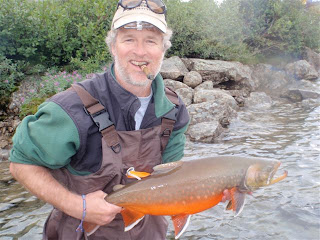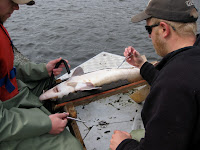Journal ArticlesAllen, P.J., C.C. Barth, S.J. Peake, M.V. Abrahams, and W.G. Anderson. 2009. Cohesive social behavior shortens the stress response: the effects of conspecifics on the stress response in lake sturgeon,
Acipenser fulvescens Rafinesque. J. Fish Biol. 74:90-104.
Barth, C.C., S.J. Peake, P.J. Allen, and W.G. Anderson. 2009. Habitat utilization of juvenile lake sturgeon,
Acipenser fulvescens, in a large Canadian river. J. Appl. Ichthyol. 25:18-26.
Blanar, C.A., K.R. Munkittrick, J. Houlahan, D.L. MacLatchy, and D.J. Marcogliese. 2009. Pollution and parasitism in aquatic animals: A meta-analysis of effect size. Aquat. Toxicol. 93:18-28.
Blessent, D., R. Therrien, and K.T.B. MacQuarrie. 2009. Coupling geological and numerical models to simulate groundwater flow and contaminant transport in fractured media. Comput. Geosci. 35(9): 1897-1906.
Bosker, T. and K.R. Munkittrick. 2009. Often Overlooked: Biological QA/QC. Learned Discourse. Integr. Environ. Assess. Manage. 5:489-491.
Bosker T., K.R. Munkittrick, and D.L. MacLatchy. 2009. Challenges in current adult fish laboratory reproductive tests: suggestions for refinement using a mummichog (
Fundulus heteroclitus) case study. Environ. Toxicol. Chem. In press -
online pre-print.
Buffagni A., S. Erba, and D.G. Armanini. 2009. The lentic-lotic character of Mediterranean rivers and its importance to aquatic invertebrate communities. Aquatic Sciences. In press -
online pre-print.
Daigle, A., A. St-Hilaire, V. Ouellet, J. Corriveau, T.B.M.J. Ouarda, L. Bilodeau. 2009. Diagnostic study and modeling of the annual positive water temperature onset. J. Hydrol. 370:29-38.
Danielescu, S., K.T.B. MacQuarrie, and R.N. Faux. 2009. The integration of thermal infrared imaging, discharge measurements and numerical simulation to quantify the relative contributions of freshwater inflows to small estuaries in Atlantic Canada. Hydrol. Processes. 23(20): 2847-2859.
Guillemette, N. A. St-Hilaire, T.B.M.J. Ouarda, N. Bergeron, E. Robichaud, L. Bilodeau. 2009. Feasibility study of a geostatistical modelling of monthly maximum s stream temperatures in multivariate space. J. Hydrol. 364:1-12.
González-Sansón, G., C. Aguilar, I. Hernández, Y. Cabrera1, and R.A. Curry. 2009. Factors influencing fish assemblages of coral reefs along the Northwestern Cuban shelf. Gulf Coast Res. 21: 13-21.
Irving E., D.J. Baird and J.M. Culp. 2009. Cadmium toxicity and uptake by mats of the freshwater diatom:
Navicula pelliculosa (Bréb) Hilse. Arch. Environ. Contam. Toxicol. 57: 523-530.
Jardine, T.D., K.A. Kidd, R.A. Cunjak, P.A. Arp. 2009. Factors affecting water strider (
Hemiptera: Gerridae) mercury concentrations in lotic systems. Environ. Toxicol. Chem. 28(7):1480–1492.
Lopes I., N. Martins, D.J. Baird, and R. Ribeiro. 2009. Genetic erosion and population resilience in
Daphnia longispina O.F. Müller under simulated predation and metal pressures. Environ. Toxicol. Chem. 28: 1912-1919.
Marziali L., D.G. Armanini, M. Cazzola, S. Erba, E. Toppi, A. Buffagni, and B. Rossaro. 2009. Responses of chironomid larvae (insecta, diptera) to ecological quality in mediterranean river mesohabitats (South Italy). Riv. Res. Appl. In press -
online pre-print.
Pestana J.L.T., S. Loureiro, D.J. Baird, and A.M.V.M. Soares. 2009. Fear and loathing in the benthos: responses of aquatic insect larvae to the pesticide imidacloprid in the presence of chemical signals of predation risk. Aquat. Toxicol. 93: 138-149.
Pestana J.L.T., A.C. Alexander, J.M. Culp, D.J. Baird, A.J. Cessna, and A.M.V.M. Soares. 2009. Structural and functional responses of benthic invertebrates to imidacloprid in outdoor stream mesocosms. Environ. Pollut. 157: 2328-2334.
Pooley, K.E., M. Blessing, T.C. Schmidt, S.B. Haderlein, K.T.B. MacQuarrie, and H. Prommer. 2009. Aerobic biodegradation of chlorinated ethenes in a fractured bedrock aquifer: quantitative assessment by compound-specific isotope analysis (CSIA) and reactive transport modeling. Environ. Sci. Technol. 43(19): 7458-7464.
Satapornvanit K., D.J. Baird, and D.C. Little. 2009. Laboratory toxicity test and post-exposure feeding inhibition using the giant freshwater prawn
Macrobrachium rosenbergii. Chemosphere 74: 1209-1215.
Wyn, B., K.A. Kidd, N. Burgess, R.A. Curry. 2009. Mercury bioaccumulation through the acidic food webs of Kejimkujik National Park and National Historic Site, Nova Scotia. Can. J. Fish. Aquat. Sci. 66:1532-1545.
Book ChaptersCurry, R.A., R.M. Hughes, M. McMaster, and D. Zafft. 2009. Coldwater Fish in Rivers. Chapter 9. In Standard Sampling Methods for North American Freshwater Fishes. Editors: S. Bonar, W. Hubert, and D. Willis. AFS Publications, Bethesda, MD. pp. 139-158.
Monk, W.A. and R.A. Curry. 2009. Ecological significance of spatial and temporal variability in stream temperatures across north-eastern North America. In Challenges for Diadromous Fishes in a Dynamic Global Environment. Editors: Haro, A. J., K. L. Smith, R. A. Rulifson, C. M. Moffitt, R. J. Klauda, M. J. Dadswell, R. A. Cunjak, J. E. Cooper, K. L. Beal, and T. S. Avery. American Fisheries Society, Symposium 69, Bethesda, Maryland. pp. 139-158.
Peer-reviewed Conference Proceedings
Daigle, A., A. St. Hilaire, J. Diatezua, N. Thiémonge and T. Ouarda. 2009. Multivariate and trend analysis of low flow hydrological indices in Québec (with André St-Hilaire, Jacquie Diatezua, INRS-ETE; Nathalie Thiémonge, Hydro-Québec; Taha Ouarda, INRS-ETE; and Luc Roy, Hydro-Québec). 62nd Annual Conference of Canadian Water Resources Association. June 9-12 in Québec City QC, Canada.
Danielescu, S., K.T.B. MacQuarrie, and R.N. Faux. 2009. Quantification of groundwater discharge to two small estuaries in Prince Edward Island. Proceedings of GeoHalifax - 10th Joint Canadian Geotechnical Society/International Association of Hydrogeologists (Canadian National Chapter) Groundwater Conference, Halifax, NS, September 2009, p. 1281-1288.
Es-Salhi, M.A. 2009. Analyse comparative des concentrations de solides en suspension en aval de tourbières exploitées: Est-ce que l'ajout de structures hydrauliques simples augmente l'efficacité des bassins de sédimentation?62nd Annual Conference of Canadian Water Resources Association. June 9-12 in Québec City QC, Canada.
Morton, S., K.T.B. MacQuarrie, and D. Connor. 2009. Measuring the hydraulic response due to aquifer clogging in the vicinity of municipal pumping wells. Proceedings of GeoHalifax - 10th Joint Canadian Geotechnical Society/International Association of Hydrogeologists (Canadian National Chapter) Groundwater Conference, Halifax, NS, September 2009, p 1323-1330.
Ouellet, V., Y. Secrétan, J. Morin, A. St-Hilaire and M. Mingelbier. 2009. Validation d’un algorithme de modélisation de la température de l’eau pour le fleuve Saint-Laurent. 62nd Annual Conference of Canadian Water Resources Association. June 9-12 in Québec City QC, Canada.
Rohde, H., B. Stewart, J. R. Lawrence, G. Swerhone, L. Wassenaar, D. Korber, P. Medihala, K. MacQuarrie, D. Connor, and S. Morton. 2009. City of North Battleford water well capture zone study. Proceedings of GeoHalifax - 10th Joint Canadian Geotechnical Society/International Association of Hydrogeologists (Canadian National Chapter) Groundwater Conference, Halifax, NS, September 2009, p. 1469-1476.
Tardif S., St-Hilaire A., Ovidio M. 2009. Modélisation statistique des régimes thermiques des affluents de la Meuse. 2nd Annual Conference of Canadian Water Resources Association. June 9-12 in Québec City QC, Canada.
Tardif S., St-Hilaire A., Roy R., Bernier M., Payette S. 2009. Hydrological comparison of aqualysed fens and lakes in the La Grande Rivière drainage basin. Part.II. 62nd Annual Conference of Canadian Water Resources Association. June 9-12 in Québec City QC, Canada.
ReportsBenyahya, L., A. Daigle, D. Caissie, D. Beveridge, and A. St-Hilaire. 2009. Caractérisation du régime naturel du débit des bassins versants de l’Est du Canada. Québec: INRS - Centre Eau Terre Environnement; Rapport de recherche R-1057. 88 pages.
Bruce, J.P., W. Cunningham, A. Freeze, R. Gillham, S. Gordon, S. Holysh, S. Hrudey, W. Logan, K. MacQuarrie, P. Muldoon, L. Nowlan, J. Pomeroy, S. Renzetti, B. Sherwood Lollar, and R. Therrien. 2009. The Sustainable Management of Groundwater in Canada, Council of Canadian Academies, Ottawa, ISBN 978-1-926558-11-0.
Gautreau, M.D. and R.A. Curry. 2009. Assessment of COSEWIC species of concern, the redbreast sunfish, and proposed threatened species, striped bass, in Grand Lake Meadow waters. New Cooperative Fish and Wildlife Research Unit, Fisheries Report #03-09.
Luiker, E., J.M. Culp, L. Noel, and R.A. Curry. 2009. Are nutrient criteria protective of ecosystem health of the St. John River? New Cooperative Fish and Wildlife Research Unit, Fisheries Report #01-09.
Monk, W.A. and R.A. Curry. 2009. Planning and Managing for Surface Water Abstraction on Prince Edward Island. New Cooperative Fish and Wildlife Research Unit, Fisheries Report #02-09.
St-Hilaire, A., A. Daigle, D. Beveridge, D. Caissie, and L. Benyahya. 2009. Analyse multivariée des indices d’altération hydrologique de l’Est du Canada. Québec: INRS - Centre Eau Terre Environnement;Rapport de recherche R-1058. 44 pages.
St-Hilaire, A. 2009. Test préliminaire d’une sonde de mesure de la densité de la neige : Hiver 2008. Rapport de recherche R1039, iii+8pages.
Valois, A., R. A. Curry, and S. M. Coghlan. 2009. Smallmouth bass (Micropterus dolomieu) invasion of Gulf Region rivers: evaluating the impact on Atlantic salmon (Salmo salar) populations. DFO Can. Sci. Advis. Sec. Res. Doc. 2009/nnn. vi + xx p.

 Please mark your calendar (if you have not already) to attend both the public and research lectures by this year's HBN Hynes Lecturer - Dr. Faye Hicks.
Please mark your calendar (if you have not already) to attend both the public and research lectures by this year's HBN Hynes Lecturer - Dr. Faye Hicks.




























kidd.jpg)







